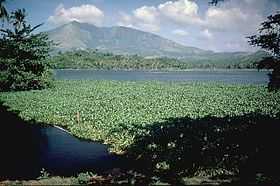Mount Iriga
From Wikipedia, the free encyclopedia
| Mount Iriga | |
|---|---|
| Mount Asog | |
 | |
| Elevation | 1,196 m (3,924 ft)[1] |
| Prominence | 1,009 m (3,310 ft) |
| Location | |
.svg.png) Mt. Iriga | |
| Location | Camarines Sur, Philippines |
| Coordinates | 13°27′24″N 123°27′24″E / 13.45667°N 123.45667°ECoordinates: 13°27′24″N 123°27′24″E / 13.45667°N 123.45667°E[1] |
| Geology | |
| Type | Stratovolcano |
| Age of rock | Quaternary |
| Volcanic arc/belt | Babuyan (Bashi) Segment of Luzon-Taiwan Arc |
| Last eruption | 1642 |
Mount Iriga, also known as Mount Asog, is one of the active volcanos in the Philippines, in the province of Camarines Sur, in the Philippines.
Mount Iriga is a stratovolcano about a kilometre from Lake Buhi. It rises 1,196 m (3,924 ft) with a base diameter of 10 kilometres.[1][2]
Iriga erupted in 1628 and 1642.[2] Iriga is generally known for its phreatic explosions.
See also
- Potentially active volcanoes in the Philippines
- Inactive volcanoes in the Philippines
- Philippine Institute of Volcanology and Seismology
- Iriga City
References
- ↑ 1.0 1.1 1.2 "Iriga". Global Volcanism Program, Smithsonian Institution. http://www.volcano.si.edu/world/volcano.cfm?vnum=0703-041. Retrieved 2011-09-17.
- ↑ 2.0 2.1 "Mount Iriga". Philippine Institute of Volcanology and Seismology (PHIVOLCS). Retrieved 2011-09-17.
This article is issued from Wikipedia. The text is available under the Creative Commons Attribution/Share Alike; additional terms may apply for the media files.